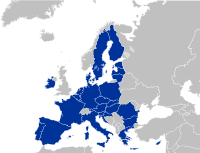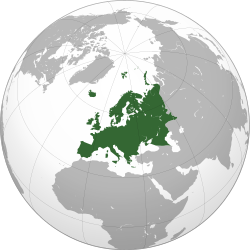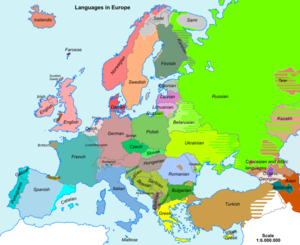Print version
| This is the print version of Wikijunior Europe You won't see this message or any elements not part of the book's content when you print or preview this page. |
Table of contents
Europe Introduction (Europe) European Union (EU) Geography of Europe People of Europe Language of Europe
Andorra Belgium Denmark France Iceland° Ireland¹ Liechtenstein Luxembourg¹ Netherlands¹ Norway Portugal¹ Switzerland United Kingdom¹
Albania Bosnia Herzegovina Croatia° Cyprus*¹ Greece¹ Italy¹ Malta¹ Monaco Montenegro° San Marino Slovenia¹ Spain¹ Vatican City
Austria¹ Czech Republic¹ Estonia¹ Finland¹ Germany¹ Hungary¹ Latvia¹ Lithuania¹ Macedonia° Poland¹ Serbia Slovakia¹ Sweden¹
Armenia* Azerbaijan* Belarus Bulgaria¹ Georgia* Kazakhstan* Moldova Romania¹ Russia* Turkey* Ukraine
Europe Introduction (Europe)
Europe is a continent which is home to more than a quarter of the world's countries. The climate of Europe varies from Arctic conditions to temperate in the south. Every world religion is represented in Europe and hundreds of languages are spoken too.
What is Europe?
Europe extends from Iceland in the west to Russia and Georgia in the east, Norway in the far north to Spain in the south. The map below shows geographical Europe, the countries generally referred to as Western Europe are highlighted in yellow. There are 50 countries in Europe at the moment although a few of these (Russia, Cyprus, etc.) are considered to be mostly or entirely in Asia. However, they are considered European for social-political, cultural, or other reasons. As well as these 50 countries, there are a number of small dependent territories which have their own governments but are not sovereign countries, such as the Faroe Islands and the Isle of Man.
What is WikiJunior Europe about?
Wikijunior is a part of Wikibooks which is devoted to creating books for children and teenagers. These books must be useful and accurate but they should also be interesting to read and not too in-depth. Wikijunior Europe provides a profile of each country with maps and flags plus information about the history, people and geography of each country. If you are reading this and wondering where to get more information, try the Web links for more detail on each country.
Is Europe the same as the European Union?
Europe is a geographic entity which runs from the Atlantic Ocean to the Ural mountains (which are in western Russia). The European Union (EU) is a political, social and economic union of 27 countries in Europe. The members of the European Union (in order of when they joined) are: France, Germany, Italy, Belgium, Luxembourg, Netherlands, Denmark, Ireland, Greece, Spain, Portugal, Austria, Sweden, Finland, Poland, Lithuania, Latvia, Estonia, Czech Republic, Slovakia, Hungary, Slovenia, Malta, Cyprus, Romania, Bulgaria and Croatia.
There are also several countries which are in talks with the European Union about joining it. These countries Albania, North Macedonia, Montenegro, Serbia and Turkey. Other European countries (e.g. Bosnia and Herzegovina, Kosovo) have also said that they wish to join the European Union in the future. The United Kingdom left the European Union in 2020.
What are the languages of Europe?
More than 100 languages are spoken in Europe. The most spoken languages are German, English, French, Russian, Spanish, Italian and Polish. Visit Wikijunior Languages to find out more about European languages and other languages from around the world.
What are the religions of Europe?
Like every other continent, all religions are practised in Europe. Christianity is by far the most common religion and almost every country in Europe has a majority of people who are Christian. Islam is the major religion in Turkey and Azerbaijan and in large parts of Bosnia Herzegovina, Albania and Russia. Judaism is represented in small numbers in every country but especially in France and the United Kingdom. Indian religions like Sikhism and Hinduism are practised especially in the United Kingdom. Atheism (not believing in a god) is very common in Czech Republic (more than 50%), Estonia, the United Kingdom, Germany and many parts of Central and Eastern Europe. Visit Wikijunior World Religions to find out more about religion.
What are the currencies of Europe?
Eighteen countries in the European Union use the Euro. All countries in the European Union (except Denmark) are expected to start using the Euro in the future. Most other countries in Europe have their own currencies.
| Wikijunior Europe • Intro • EU • Geo • People • Language • Facts • Quiz | edit | ||
European Union (EU)
Warning: Display title "<span style="color:blue"><center>European Union</center></span>" overrides earlier display title "<span style="color:blue"><center>Introduction</center></span>".
What is the European Union?
The European Union is a group of 27 countries in Europe, and was formed in the 1950s. Originally it was called the Coal and Steel Community (ECSC) and the first countries were France, Germany, Italy, the Netherlands, Belgium, and Luxembourg. In 1973 the United Kingdom, Ireland, and Denmark joined, followed by Greece in 1981. In 1986 Spain and Portugal joined, and later Finland, Sweden, and Austria in 1995. In May 2004, 10 countries joined at the same time: Poland, Lithuania, Latvia, Estonia, the Czech Republic, Slovakia, Hungary, Slovenia, Malta, and Cyprus. The most recent new members are Romania and Bulgaria, which joined in 2007, and Croatia, which joined in in 2013. The UK left the EU in 2020.
These countries trade with each other in a common market, meaning that goods can be sold and bought freely across the union. People can also live and work (with some restrictions) in any EU country if they are an EU citizen. Member countries also have some common laws derived from decisions made by the union. Each country in the EU also elects politicians to a European Parliament which helps make and decide what common goals the union should pursue. Fifteen countries in the European Union also share a common currency: the Euro.

Which countries are in the EU?
There are 27 countries in the EU which has a population of around 450 million and the largest economy in the world.
The members are (in order of when they joined): France, Italy, Germany, Luxembourg, Netherlands, Belgium, Denmark, Ireland, Greece, Spain, Portugal, Finland, Sweden, Austria, Poland, Lithuania, Latvia, Estonia, Czech Republic, Slovakia, Hungary, Slovenia, Malta, Cyprus, Romania, Bulgaria and Croatia.
Macedonia, Turkey, Montenegro, Serbia, and Albania are applicant countries who wish to join the European Union in the future.
In June 2016 the British people voted to leave the EU in a referendum. The UK left the EU in January 2020.
Which countries use the euro?
Seventeen of the twenty-seven EU member countries use the euro as their currency: France, Germany, Italy, Netherlands, Belgium, Luxembourg, Ireland, Greece, Spain, Portugal, Austria, Finland, Slovenia, Cyprus, Malta, Slovakia, Estonia and Latvia. All other members (except Denmark) are obliged by the 1992 Maastricht Treaty to adopt the euro at some point in the future.
In addition, a few smaller countries which are not part of the EU also use the euro: the Vatican City, San Marino, Monaco, Andorra, Montenegro, and Kosovo, a former province of Serbia recognised as independent by most (24 out of 28) EU members, but not by Serbia and many other countries.
Which countries have "open borders"?

The Schengen Agreement was signed by many countries in Europe (including some which are not part of the EU). Countries which have singed up to this agreement have no border controls between similar countries. This means that you can travel from Portugal to Spain to France to Germany to Poland to Lithuania to Latvia to Estonia and Finland (several thousand kilometres) and you don't need to stop at borders or show passports.
The following countries have signed the agreement and removed border controls: Portugal, Spain, France, Luxembourg, Belgium, Netherlands, Germany, Denmark, Iceland (not part of the EU), Sweden, Norway (not part of the EU), Finland, Estonia, Latvia, Lithuania, Poland, Slovakia, Czech Republic, Austria, Switzerland (not part of the EU), Italy, Malta, Slovenia, Hungary, and Greece. Liechtenstein joined at the end of 2011. The only EU countries where passports are still needed to enter from other EU countries are the Ireland, Cyprus, Romania and Bulgaria. Ireland and former EU member, the UK, form the Common Travel Area, which is similar to the Schengen Area in that there are very few border controls between the two countries.
| Wikijunior Europe • Intro • EU • Geo • People • Language • Facts • Quiz | edit | ||
Geography of Europe
Warning: Display title "<span style="color:blue"><center>Print version</center></span>" overrides earlier display title "<span style="color:blue"><center>European Union</center></span>".
Europe is a continent of over 50 countries with a border that is largely undefined (defining which countries are European and which aren't is argued a lot) and with many different landscapes, climates and wildlife.

Islands of Europe

Europe has many thousands of islands and some of these are countries (Iceland and Cyprus, for example). The largest islands are Iceland, Great Britain, Ireland (includes the country called "Ireland" and Northern Ireland which is part of the UK), Sicily, Spitsbergen and Sardinia.

Mountains of Europe
In the east of the continent are the Ural mountains (click the mountain links to read the article on Wikipedia) which separate Europe from Asia. North of the Mediterranean Sea are the Alps which run through France, Switzerland, Italy, Germany, Austria and Slovenia. In the centre and south of the continent are the Carpathian Mountains.
Climate of Europe
The far north (Iceland, Norway, Sweden, Finland and Russia) pass through the Arctic Circle which is the area near the North Pole where temperatures can be very low. Countries to the east and inland of Europe can have very cold winters but those in the west have milder winters because of warmth from the Gulf Stream which brings hotter temperatures. Southern areas around the Mediterranean Sea can have constantly hot summers and pleasant winters.
Volcanoes and Other Natural Occurrences in Europe

Europe has 11 volcanoes. The second-highest and most famous is Etna in Sicily, Italy at 3,263 metres. It is well-known for its height, its close location to the major city of Catania and its constant eruptions over the past few years. Europe's highest volcano is Pico del Teide in the Canary Island, Spain.
Landlocked Countries
A landlocked country is a country which has no connection to a sea or ocean. Countries like Georgia and Ukraine are not landlocked because they have coastlines on the Black Sea. There are 16 landlocked countries in Europe: Andorra, Armenia, Austria, Belarus, Kosovo, Czechia, Hungary, Liechtenstein, Luxembourg, North Macedonia, Moldova*, San Marino, Serbia, Slovakia, Switzerland and Vatican City. Liechtenstein is unique in Europe because it is doubly-landlocked meaning it is both landlocked and surrounded by countries which are also landlocked, a situation it only shares with Uzbekistan which is the second country in the world surrounded only by landlocked countries (Turkmenistan, Kazakhstan, Kyrgyzstan, Tajikistan and Afghanistan). Although the state of Kosovo is placed as a landlocked countries in the Europe, the state has not obtained the country status. If the Serbian breakaway Kosovo is considered as the country, the Moldovan breakaway part Transnistria need to be recognized as another landlocked countries of the Europe. Hence, if we count only the UN recognized countries there are 15 landlocked countries in Europe, or the 17 countries along with breakaway regions.
| Wikijunior Europe • Intro • EU • Geo • People • Language • Facts • Quiz | edit | ||
People of Europe
Warning: Display title "<center><span style="color:blue">Wikijunior Europe: Print version</span></center>" overrides earlier display title "<span style="color:blue"><center>Print version</center></span>".
Europeans

745 million people live in Europe. The largest countries, by population, are Russia (143 million but many of these live in Asian parts of Russia) and Germany (80 million). The smallest countries, by population, are the Vatican City (1,000 inhabitants), Monaco, San Marino and Liechtenstein.
Religion
The major religion in Europe is Christianity. Most countries in Europe have a majority of people who are Christian - generally Roman Catholic (most of southern Europe, central Europe and Ireland), Protestant varieties (the UK, Germany and parts of central Europe) and Orthodox (eastern and south-eastern Europe). Large minorities of

Jews live in the UK and France (and Poland, Germany and central Europe in the past). Turkey, Albania, Kosovo and Azerbaijan have majority Muslim populations with large numbers also in Bosnia Herzegovina and Russia. Several countries including Czech Republic, Estonia and the United Kingdom have large numbers of people who don't follow any religion
Languages
Over 100 languages are spoken today in Europe and many hundreds of others were spoken in the past. The European Union has 24 official languages although there are 28 countries in the EU. This is because some languages are spoken in more than one country. English is spoken in the United Kingdom, Ireland and Malta. German is an official language in Germany, Austria and parts of Belgium. French is spoken in France and Belgium. Russian is the main language in Russia and is also spoken by large numbers of people in Ukraine, Belarus and other countries which were formerly part of the Soviet Union. Italian is spoken in Italy and also in parts of Slovenia and Croatia.
The most spoken native EU language is German. English is spoken by more people as a second language than any other language in the EU.
There are many languages in Europe which don't have large numbers of native speakers like Manx and Kashubian.
- Images of European People
-
Albert Einstein, scientist from Germany
-
Pope John Paul II from Poland
-
Oscar Wilde, writer from Ireland
-
Yuri Gagarin, cosmonaut from Russia
-
David Beckham, footballer from the United Kingdom
-
Mozart, composer from Austria
-
Pablo Picasso, artist from Spain
-
Nikola Tesla, inventor from Serbia
-
Leonardo Da Vinci, artist from Italy
-
Alfred Nobel, scientist from Sweden
-
Rita Ora, singer from Kosovo
|
| ||||||
Language of Europe
Warning: Display title "<span style="color:blue"><center>Print version</center></span>" overrides earlier display title "<center><span style="color:blue">Wikijunior Europe: Print version</span></center>".
Languages of Europe
Russian is the language spoken by the most people in Europe with native speakers found in Russia, Ukraine, Belarus, Kazakhstan, Armenia, Azerbaijan, Georgia, Estonia, Latvia and other parts of Europe.
The European Union has 24 official languages. Many Europeans speak 2 or 3 languages but the most common language to learn, by a long way, is English.

Most languages spoken in Europe are Indo-European languages which are languages which originated between Europe and India. The Indo-European languages in Europe can be divided into different groups:
- Albanian - spoken in Albania, Kosovo, and North Macedonia
- Armenian - spoken in Armenia
- Baltic Languages - Lithuanian (in Lithuania) and Latvian (in Latvia)
- Celtic Languages - Welsh, Scottish Gaelic, Cornish and Manx, all spoken in the United Kingdom or countries which depend on the UK. Also Irish and Breton, spoken in Ireland and France.
- Germanic Languages - English (UK, Ireland and Malta), German (Germany, Austria and Switzerland), Dutch (Netherlands and Belgium), Danish (Denmark), Norwegian (Norway), Swedish (Sweden and Finland) and Icelandic (Iceland).
- Greek - spoken in Greece and Cyprus.
- Romance Languages - Catalan (Spain), French (France, Switzerland, Belgium), Italian (Italy and Slovenia), Portuguese (Portugal), Romanian (Romania and Moldova), Sardinian (Italy), Sicilian (Italy) and Spanish (Spain).
- Slavic Languages - Russian (Russia, Kazakhstan, Ukraine and Belarus), Ukrainian (Ukraine), Belarusian (Belarus), Czech (Czech Republic), Polish (Poland), Slovak (Slovakia), Bulgarian (Bulgaria), Macedonian (Macedonia), Slovene (Slovenia and Italy) and Serbian/Croatian/Montenegrin/Bosnian (Serbia, Croatia, Montenegro and Bosnia Herzegovina)
There are a few languages spoken in Europe which are not Indo-European languages:
- Kartvelian Languages - this group includes Georgian, spoken in Georgia.
- Uralic Languages - this group includes Estonian (Estonia), Finnish (Finland) and Hungarian (Hungary and Serbia)
- Turkic Languages - this group includes Turkish (Turkey and Cyprus), Azerbaijani (Azerbaijan) and Kazakh (Kazakhstan)
- Semitic Languages - this group includes Maltese (Malta)
All of the languages above - those in the Indo-European Language group or those from other groups are all related in some way to other languages. There is one language spoken in Europe which has no relation to any other language in the world:
- Basque - spoken in Spain and France.
You can read more about European languages and other world languages at Wikijunior Languages
Alphabets of Europe

- The Latin alphabet is used in most of Europe. Most EU countries use this alphabet. The first letters of the Latin alphabet are: A, B, C
- The Cyrillic alphabet is used in some parts of Eastern Europe and South Eastern Europe. At present, Bulgaria is the only EU country using this alphabet. Serbia, Montenegro and Bosnia are noteworthy because both Latin and Cyrillic alphabets are regularly used in those countries. The first letters of the Russian Cyrillic alphabet are: а, б, в
- The Greek alphabet is used in Greece and Cyprus. The first letters of the Greek alphabet are: Α, Β, Γ
- The Georgian alphabet is used in Georgia. The first letters of the Georgian alphabet are: ა, ბ, გ
| Wikijunior Europe • Intro • EU • Geo • People • Language • Facts • Quiz | edit | ||












